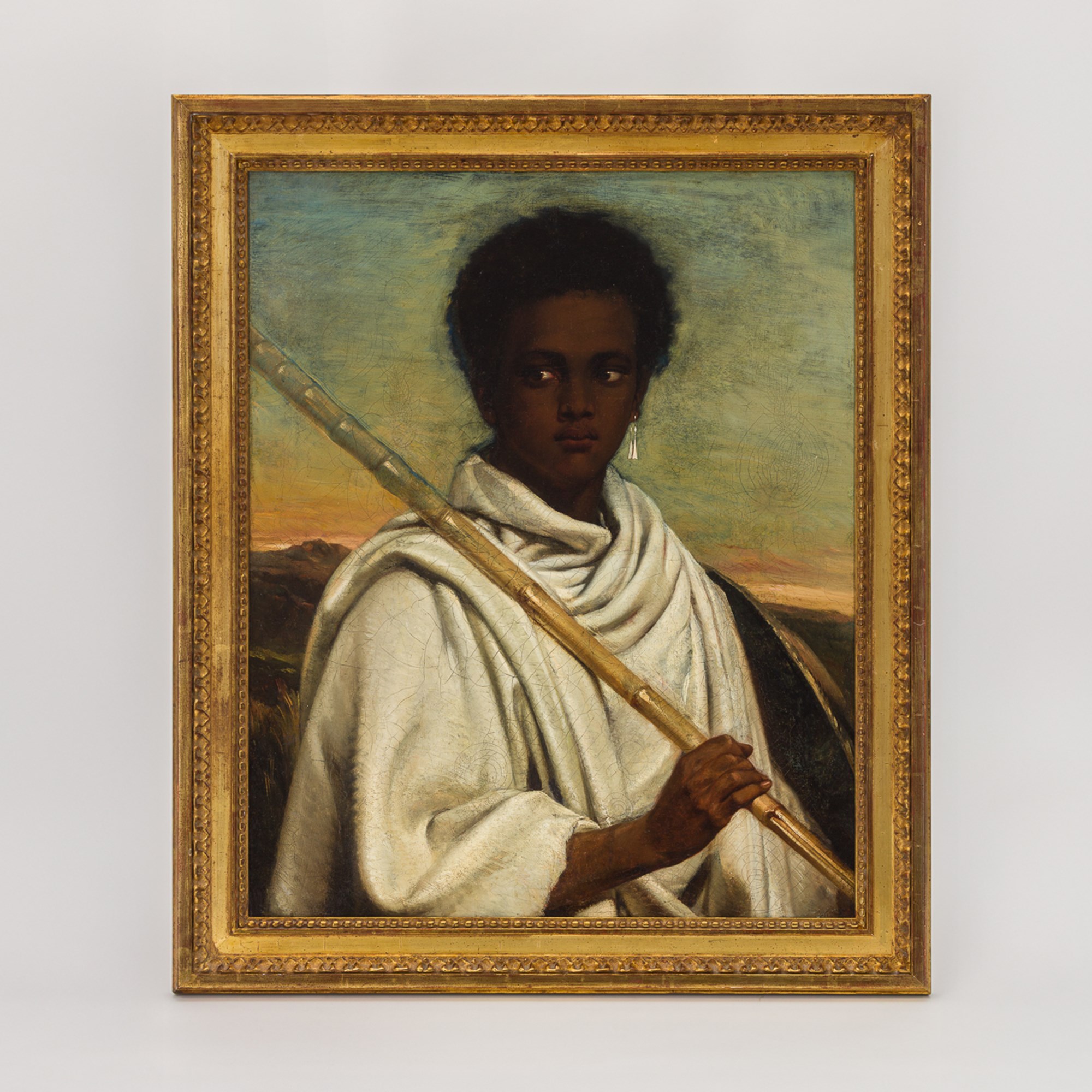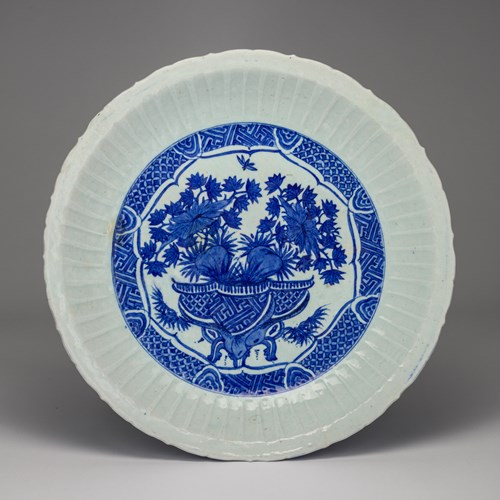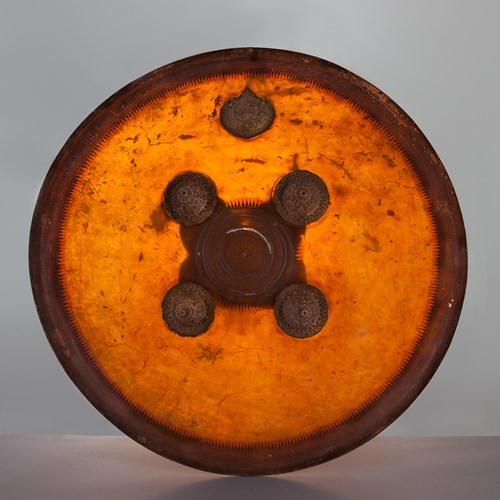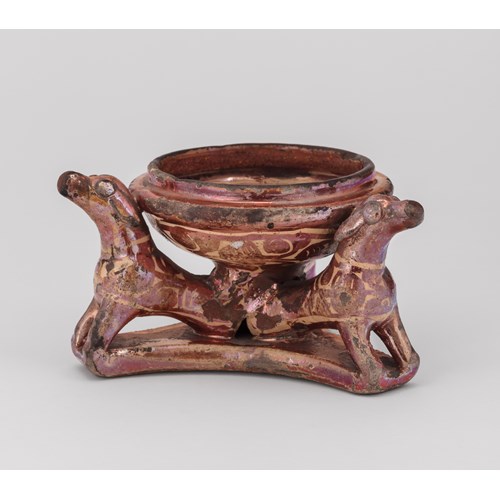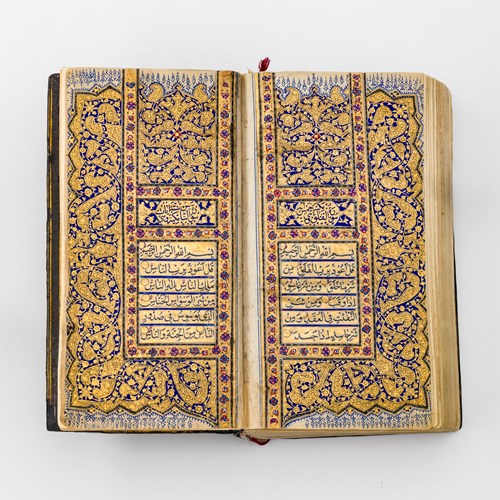Marketplace
Warrior in White
A rich European oil painting depicting a young Abyssinian warrior or hunter. A bamboo spear is balanced on his left shoulder, whilst the edge of a large round shield, known as a tafa or gasha, emerges from behind the young man. He looks off to his right, wistfully, as if observing something just behind the viewer. The distinctive white draped shawl around his neck is a shamma, clothing characteristic of Ethiopia and other parts of East Africa formerly in the Abyssinian Empire, namely Somalia and Eritrea. The background features a twilight hilly terrain. The skill of the artist is particularly evident in their handling of light and reflection, such as on the delicate fingernail and the whites of his eyes.
It is unclear whether this portrait was painted from life, be that in East Africa or Europe, or from a drawing. The 19th century was a time of large Western presence throughout Africa, notably the English, French, and Italians, who eventually colonised Abyssinia. Artists often accompanied European colonial expeditions, and this painting may be the result of this. Henry Salt, for example, accompanied a British trade mission to Ethiopia in 1810, and documented the landscape (see, for example, SP.537:1 in the Victoria & Albert Museum, London).1 When Italy entered the Scramble for Africa in the second half of the century, Italian artists began to produce illustrations.2
A number of artists employed black models in the 19th century. The most famous were the Haitian-born Joseph, who modelled for the likes of Vernet and Géricault (see, for example, Study of the Model Joseph in the Getty Museum, accession no. W201), Laure, who modelled for Manet (see Olympia in the Musée d’Orsay), Angelo Soliman, a black courtier in Austria, who was painted by Johann Nepomuk Steiner (see here), and Ira Aldridge, the actor.
A third possibility is that the painting was copied from a book or engraving. So much literature about Abyssinia was published in Europe that it is possible that a European artist painted this based on a printed image. The sailor and traveller Théophile Lefebvre wrote an account of his travels in Abyssinia which contains illustrations of men in similar attire. Notably, an illustration of Balgadda Araya, chief of the Enderta province, bears a particular resemblance to our subject.3 The picture was drawn from a description rather than from life, so is unlikely to be accurate. However, it was reproduced in several publications, including W. H. G. Kingston’s Great African Travellers, where he was labelled as ‘Susi’, the Central African travelling companion of Dr. Livingstone.4
[1] Derillo, Eyob. ‘Henry Salt and the Highlands of Ethiopia (Abyssinia)’, British Library Asian and African Studies Blog, retrieved online via https://blogs.bl.uk/asian-and-african/2015/12/henry-salt-and-the-highlands-of-ethiopia-abyssinia.html on 05/06/2025; See Salt, Henry. A Voyage to Abyssinia…London: W. Bulmer, 1814.
[2] See, for example, Passini, Lazzaro. Usi e costume dell’Abissinia e dei dintorni di Massaua. Milan: Antonio Vallardi, 1890.
[3] See Lefebvre, Théophile. Voyage en Abyssinie, execute pendant les années 1839, 1840, 1841, 1842, 1843. Paris : Arthus Bertrand,
[4] Kingston, William Henry Giles. Great African Travellers: From Mungo Park to Livingstone and Stanley. London: Routledge, 1874, p. 506.
It is unclear whether this portrait was painted from life, be that in East Africa or Europe, or from a drawing. The 19th century was a time of large Western presence throughout Africa, notably the English, French, and Italians, who eventually colonised Abyssinia. Artists often accompanied European colonial expeditions, and this painting may be the result of this. Henry Salt, for example, accompanied a British trade mission to Ethiopia in 1810, and documented the landscape (see, for example, SP.537:1 in the Victoria & Albert Museum, London).1 When Italy entered the Scramble for Africa in the second half of the century, Italian artists began to produce illustrations.2
A number of artists employed black models in the 19th century. The most famous were the Haitian-born Joseph, who modelled for the likes of Vernet and Géricault (see, for example, Study of the Model Joseph in the Getty Museum, accession no. W201), Laure, who modelled for Manet (see Olympia in the Musée d’Orsay), Angelo Soliman, a black courtier in Austria, who was painted by Johann Nepomuk Steiner (see here), and Ira Aldridge, the actor.
A third possibility is that the painting was copied from a book or engraving. So much literature about Abyssinia was published in Europe that it is possible that a European artist painted this based on a printed image. The sailor and traveller Théophile Lefebvre wrote an account of his travels in Abyssinia which contains illustrations of men in similar attire. Notably, an illustration of Balgadda Araya, chief of the Enderta province, bears a particular resemblance to our subject.3 The picture was drawn from a description rather than from life, so is unlikely to be accurate. However, it was reproduced in several publications, including W. H. G. Kingston’s Great African Travellers, where he was labelled as ‘Susi’, the Central African travelling companion of Dr. Livingstone.4
[1] Derillo, Eyob. ‘Henry Salt and the Highlands of Ethiopia (Abyssinia)’, British Library Asian and African Studies Blog, retrieved online via https://blogs.bl.uk/asian-and-african/2015/12/henry-salt-and-the-highlands-of-ethiopia-abyssinia.html on 05/06/2025; See Salt, Henry. A Voyage to Abyssinia…London: W. Bulmer, 1814.
[2] See, for example, Passini, Lazzaro. Usi e costume dell’Abissinia e dei dintorni di Massaua. Milan: Antonio Vallardi, 1890.
[3] See Lefebvre, Théophile. Voyage en Abyssinie, execute pendant les années 1839, 1840, 1841, 1842, 1843. Paris : Arthus Bertrand,
[4] Kingston, William Henry Giles. Great African Travellers: From Mungo Park to Livingstone and Stanley. London: Routledge, 1874, p. 506.
Plus d'œuvres d'art de la Galerie


